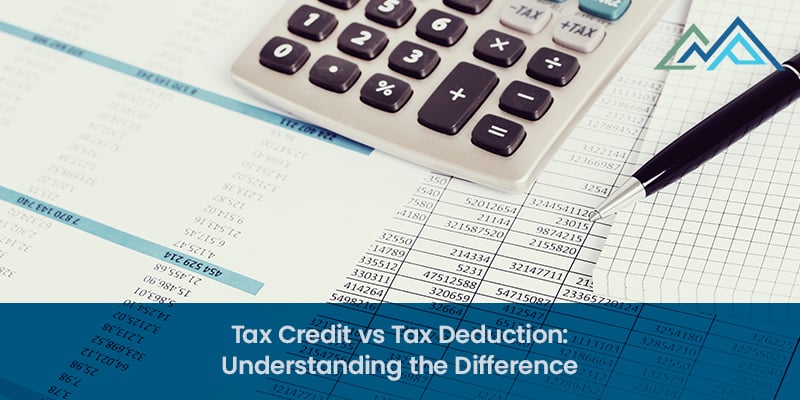People who want to save money on their taxes can do so with a combination of tax credits and tax deductions. Used in combination, credits, and deductions can reduce your taxable income and your tax liability.

At CMP, a Utah CPA firm, we work with taxpayers every day to help them prepare their tax returns and save money where they can. One of the questions we hear a lot is this:
What is the difference between a tax credit and a tax deduction?
We love answering this question because it highlights a common misunderstanding. People sometimes use the terms tax credit and tax deduction interchangeably, but they differ.
What is a Tax Credit?
Let's start with tax credits. Simply stated, a tax credit is a specified amount that can be subtracted directly from the tax you owe. Credits are tied to qualifications that are laid out in the tax code, and only those who meet the qualifications can take them.
Examples of tax credits you may have heard about include the following.
- The Earned Income tax credit (EITC)
- The Saver's tax credit
- The Child and Dependent Care tax credit
- The American Opportunity tax credit
- The Lifetime Learning tax credit
The American Opportunity tax credit offers savings for taxpayers who are paying for secondary education, while the Saver’s tax credit is designed to help those who are saving for retirement.
We will go into detail later about the different types of tax credits and how they work, but for now, you should know that credits are available to many taxpayers and if you qualify, you should take any credits you are entitled to take when you file your tax return.
How Do Tax Credits Work?
Now, let's review how tax credits work. As we noted above, any tax credit you take is subtracted directly from the amount of taxes you owe, giving you a dollar-for-dollar reduction on your tax bill. Let's look at an example.
Without any tax credits, Dan realizes that he owes $10,000 in taxes. His accountant tells him that, because he is paying for his daughter's college education, he is eligible for the American Opportunity Tax Credit. This is a credit that reimburses taxpayers for up to $2,500 in eligible expenses associated with their first four years of post-secondary education.
With the American Opportunity Tax Credit, Dan can subtract $2,500 from his $10,000 tax bill, lowering it to $7,500. We should note here that the $2,500 credit is per student, so if Dan had two children in college, he could claim $5,000 in credits.
It is important to note that tax credits do not change your income tax bracket because they do not reduce your taxable income. Instead, they serve as direct savings after you have calculated what you owe.
Check out our latest blog post on how the Big Beautiful Bill changes R&D tax credits to understand what these new updates mean for businesses looking to claim research incentives effectively.
Types of Tax Credits
While there are many different tax credits you may be eligible to take, they all fall into three basic categories based on whether you can get the credit as a refund if only partial credit is required to reduce your tax bill to zero.
Nonrefundable Tax Credits
A nonrefundable tax credit is exactly what it sounds like: a tax credit that may not be refunded under any circumstances. If you owed one dollar on your taxes and were eligible for a $1,000 credit, you could only use $1 of the credit. The remaining $999 could not be refunded to you.
An example of a nonrefundable tax credit is the Saver's Credit, which is for taxpayers who contribute to eligible retirement savings plans.
Refundable Tax Credits
A refundable tax credit, as you may have guessed, is a credit that is fully refundable when not used in its entirety. If you were due multiple credits and you could reduce your tax liability to zero without using all of a refundable tax credit, you would receive the balance as a refund from the Internal Revenue Service.
An example of a refundable credit is the EITC, which is in place to offset regressivity in the tax code that adversely impacts low-income individuals and families. Someone eligible for the EITC may receive the balance of the credit as a refund.
Partially Refundable Tax Credits
A partially refundable tax credit is one where some, but not all, of the credit, is refundable. An example is the American Opportunity Tax Credit, which we have mentioned.
If you take the American Opportunity Tax Credit and you can reduce your taxes owed to zero without using the whole credit, you may receive up to 40% of the remaining amount as a tax refund, up to a maximum of $1,000.
How Are Tax Credits Calculated?
Tax credits are calculated on a case-by-case basis. For any tax credit available, the IRS has a publication that explains how the credit works and how to determine your eligibility.
Let's use the American Opportunity Tax Credit as an example. According to the IRS website, students will receive Form 1098-T from their schools by January 31. This form is part of the process of determining your eligibility. You will also need to look at IRS Publication 970 to figure out how much to claim.
What is a Tax Deduction?
A tax deduction is something that reduces the amount of your taxable income and can potentially save you money by dropping you into a lower tax bracket. Like tax credits, tax deductions are part of the tax code, and you must meet the qualifications to take the deduction. The primary difference between tax credits and tax deductions is that credits directly reduce the amount you owe, and deductions reduce your taxable income.
Here are some examples of tax deductions:
- State & local income tax paid deduction
- Charitable contribution deduction
- Property tax deduction
- Mortgage interest deduction
The charitable contribution deduction allows taxpayers to deduct some of the donations they make to charity to reduce their taxable income, while the mortgage interest deduction is something homeowners can do to save money on their taxes.
How Do Tax Deductions Work?
Now, let's discuss how tax deductions work. As we previously stated, deductions are subtracted from your income and not from the taxes you owe. They can save you money on your taxes by reducing your Adjusted Gross Income, the figure you use to calculate your tax liability.
Let's look at an example. Melanie is a corporate executive earning $170,000 per year. Based on her income, she would be in the 32% tax bracket, meaning that she would owe $33,603 (calculated based on lower tax brackets) plus 32% of any amount she earns over $164,925 for a total amount owed of $35,227.
If Melanie used the standard deduction for someone with single filing status, she would be able to deduct $12,550 from her gross income, giving her an adjusted gross income of $157,450. That would drop her into a lower tax bracket where she would pay $14,751 plus 24% of any income over $86,375. That would reduce the amount she owes from $35,227 to $31,809.
If Melanie itemizes deductions, she could save even more than in our example. We will discuss that in the next section.
Types of Tax Deductions
There are four types of tax deductions you should know about.
Standard Deduction
The standard deduction is one every taxpayer can take if they do not itemize deductions or are not required to itemize. Here are the standard deductions for the 2023 & 2024 tax year:
2023:
- $13,850 for single filers
- $13,850 for married, filing separately
- $27,700 for married filing jointly; qualified widow/er
- $20,800 for head of household
2024:
- $14,600 for single filers
- $14,600 for married, filing separately
- $29,200 for married filing jointly; qualified widow/er
- $21,900 for head of household
If you cannot save money by itemizing your deductions, you should take the standard deduction.
Itemized Deductions
There are certain circumstances in which you may not use the standard deduction and circumstances when it is not desirable.
According to the IRS, people in the following categories may not take the standard deduction and must itemize.
- A person who is married filing separately whose spouse itemizes deductions.
- A person filing a tax return for a period that is less than 12 months due to a change in their annual accounting period.
- Nonresident aliens or dual-status aliens, except those married to a US citizen or resident alien choose to be treated as U.S. residents for tax purposes.
- An estate, partnership, or common trust fund.
If you have itemized deductions that total more than the standard deduction, then itemizing is advantageous. People who itemize deductions must use Form 1040. We explain the details of how to claim tax deductions later in this post.
Above-the-Line Tax Deductions
An above-the-line tax deduction is subtracted from your gross income to calculate your Adjusted Gross Income.
Examples of above-the-line deductions include the Health Savings Account and Alimony deductions.
Below the Line Tax Deductions
A below-the-line tax deduction is an amount that is deducted below the point where you have calculated your Adjusted Gross Income. In most cases, above-the-line deductions save taxpayers more money than below-the-line deductions.
Examples of below-the-line deductions include charitable donations and qualified medical expenses.
How to Calculate Tax Deductions
Now, let's talk about how to calculate deductions. The United States tax code is complex and can be difficult to understand. If you want to itemize deductions, you may want to work with a certified tax professional to determine which itemized deductions you can take.
As with tax credits, the rules for calculating tax deductions can be confusing. Let's look at the Health Savings Account deduction as an example. IRS Publication 969 explains the rules for both HSA contributions and deductions. You must report contributions to an HSA to the IRS using Form 8889, which must be filed with your Form 1040, 1040-SR, or 1040-NR. Your contributions will appear on your Form W-2, Box 12, Code W.
While some tax credits have separate line items on Form 1040, the same is not true of deductions. You should work with a tax professional to ensure you are taking all deductions for which you are eligible.
Itemizing vs the Standard Deduction: Which Should I Choose?
When deciding between the standard deduction and itemized deductions, you first need to consider whether you qualify to take the standard deduction. We listed the categories that disqualify you from the standard deduction above. For example, if you are married filing separately and your spouse is itemizing deductions, you must also itemize.
The only other consideration is whether you can save money by itemizing. As a reminder, the standard deductions for 2023 are $13,850 for single or married filing separately and $13,850 for married filing separately.
The best way to determine if you should itemize is to calculate your tax deductions individually and total them. You should itemize if the total amount you can deduct is higher than your standard deduction. Remember that qualified expenses related to your work may be deductible.
Keep in mind that itemizing deductions does not preclude you from taking tax credits for which you are eligible. However, the Tax Cuts and Jobs Act of 2017 nearly doubled the standard deduction, and the result is that fewer people can save by itemizing.
Filing and paying business taxes properly is crucial for small business owners. If you’re just launching a new business, you might wonder: How much are business taxes in Utah? Our guide will help you navigate your tax obligations and ensure compliance. For a detailed understanding, read our article: A 2024 Employer's Guide to Small Business Taxes in Utah.
How to Claim Tax Deductions and Tax Credits
The process of claiming tax deductions and tax credits is complex. Some of the most common tax credits have a line on Form 1040. Here are the credits you can find there:
- Earned Income Credit - Line 27
- Additional Child Tax Credit - Line 28
- American Opportunity Credit - Line 29
Other credits, such as the Saver's Tax Credit, are not listed individually. For the credits that appear on Form 1040, there are some instructions provided on Form 1040 and in the instructions for that form. For example, Form 1040 tells you that you need Schedule EIC to claim the Earned Income Tax Credit and Form 8863 to claim the American Opportunity Tax Credit. For other credits, you need to refer to the IRS website for more information.
The standard deduction is included on the first page of Form 1040 and there is no additional paperwork required. If you plan to itemize your deductions, you will do so on Schedule A (Form 1040 or 1040-SR) and put the total you calculate on Line 12 of Form 1040.
Our Tax Pros Can Help Minimize Your Tax Bill
We recognize that the process of determining your eligibility for tax credits and tax deductions may be arduous and confusing. For that reason, it is recommended that you work with a qualified tax professional if you have questions about a deductible expense or credit.
Do you need help with your income tax preparation or minimizing tax payments? Our CMP tax pros are here to help.


















